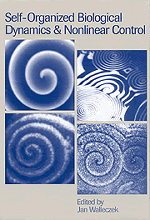 Self-Organized Biological Dynamics and Nonlinear Control
Self-Organized Biological Dynamics and Nonlinear Control Book contents
- Frontmatter
- Contents
- List of contributors
- Preface
- The frontiers and challenges of biodynamics research
- Part I Nonlinear dynamics in biology and response to stimuli
- 1 External signals and internal oscillation dynamics: principal aspects and response of stimulated rhythmic processes
- 2 Nonlinear dynamics in biochemical and biophysical systems: from enzyme kinetics to epilepsy
- 3 Fractal mechanisms in neuronal control: human heartbeat and gait dynamics in health and disease
- 4 Self-organizing dynamics in human sensorimotor coordination and perception
- 5 Signal processing by biochemical reaction networks
- Part II Nonlinear sensitivity of biological systems to electromagnetic stimuli
- Part III Stochastic noise-induced dynamics and transport in biological systems
- Part IV Nonlinear control of biological and other excitable systems
- Index
4 - Self-organizing dynamics in human sensorimotor coordination and perception
Published online by Cambridge University Press: 14 August 2009
- Frontmatter
- Contents
- List of contributors
- Preface
- The frontiers and challenges of biodynamics research
- Part I Nonlinear dynamics in biology and response to stimuli
- 1 External signals and internal oscillation dynamics: principal aspects and response of stimulated rhythmic processes
- 2 Nonlinear dynamics in biochemical and biophysical systems: from enzyme kinetics to epilepsy
- 3 Fractal mechanisms in neuronal control: human heartbeat and gait dynamics in health and disease
- 4 Self-organizing dynamics in human sensorimotor coordination and perception
- 5 Signal processing by biochemical reaction networks
- Part II Nonlinear sensitivity of biological systems to electromagnetic stimuli
- Part III Stochastic noise-induced dynamics and transport in biological systems
- Part IV Nonlinear control of biological and other excitable systems
- Index
Summary
Introduction
The human brain is composed of 100 billion to a trillion neurons and as many neuroglia. The human-and-environment system is open and complex. Human behavior is adaptive and multifunctional, arising from interactions that occur on many levels among diverse organizational components. How is the vast material complexity of the brain on the one hand and the behavioral complexity that emerges on the other to be understood? In this chapter we describe experiments that illustrate recent research efforts aimed at uncovering the basic principles and mechanisms governing the brain and behavioral function. In particular, we focus on the following specific questions. (1) How do we react to and coordinate with the environment (see Section 4.2), and (2) how do we perceive and categorize the world around us (see Section 4.3)? Our work is based on the joint premises that a more complete understanding of how the brain works will come: (1) when experimental research in the laboratory is combined with new theoretical approaches investigating how the brain functions as a whole; and (2) as a result of direct, multidisciplinary collaborations between neuroscientists, experimental psychologists, mathematicians and physicists.
Evidence for self-organized dynamics from a human sensorimotor coordination experiment
One of the simplest forms of human–environment coordination involves producing motor outputs at a specific timing relationship with regular external events. Many human activities such as music and dance depend on the efficient execution of this sensorimotor task.
- Type
- Chapter
- Information
- Self-Organized Biological Dynamics and Nonlinear ControlToward Understanding Complexity, Chaos and Emergent Function in Living Systems, pp. 97 - 111Publisher: Cambridge University PressPrint publication year: 2000


